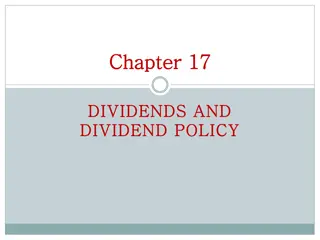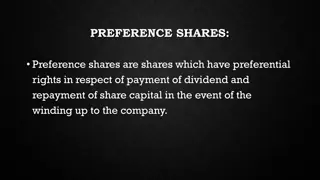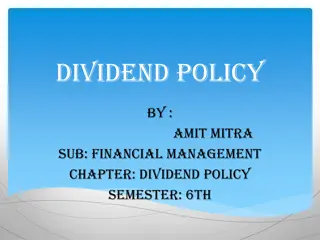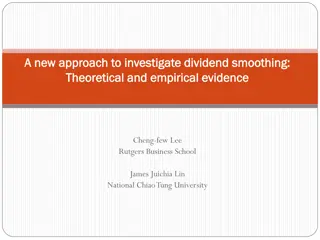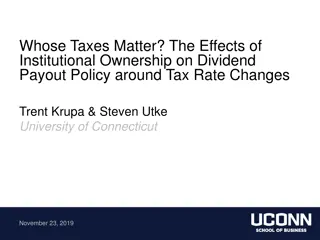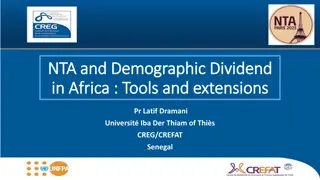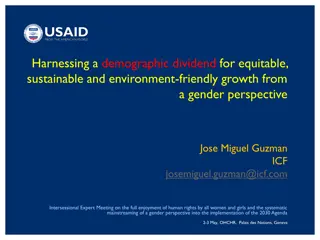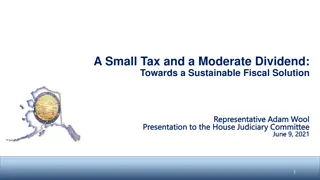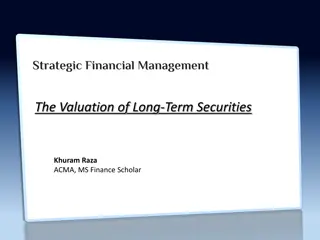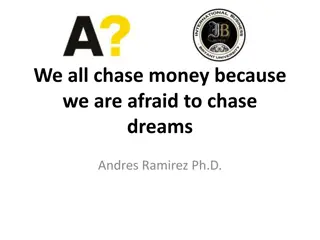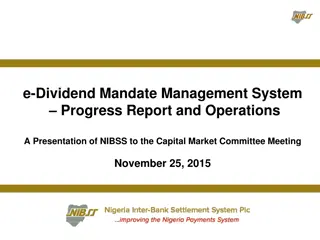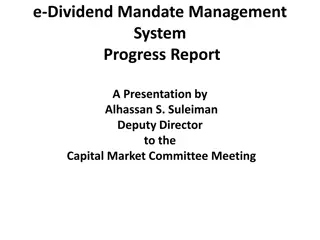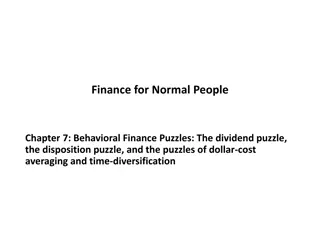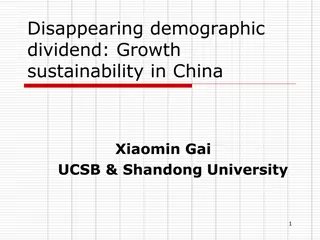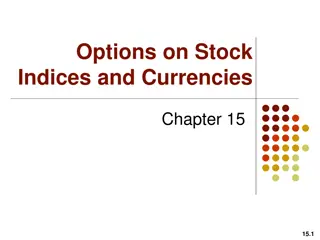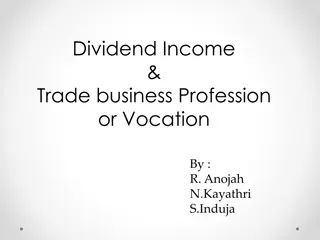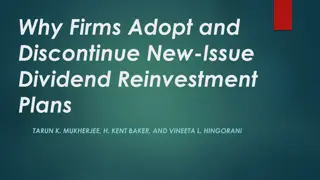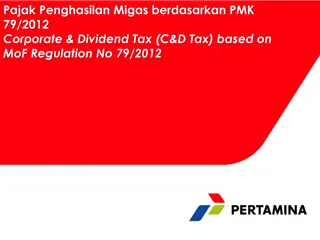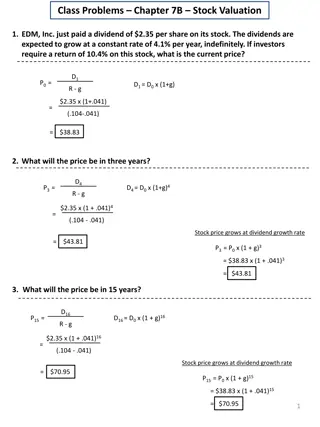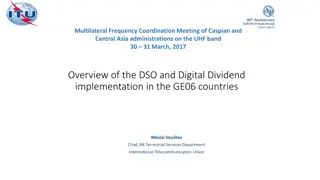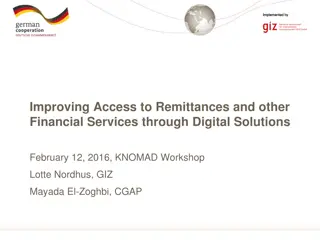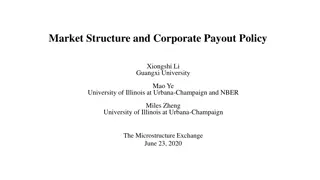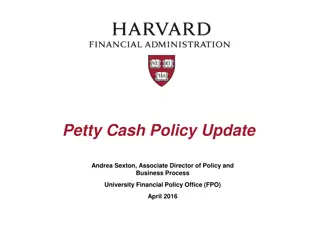Understanding Dividend Policy in Financial Management
Dividend policy plays a critical role in balancing long-term financing and shareholder wealth. It involves determining the distribution of profits among shareholders while retaining earnings for company growth. Approaches like Long Term Financing and Wealth Maximisation influence dividend decisions, impacting shareholder preferences for immediate dividends or future income. Different kinds of dividends, such as Cash Dividend, Scrip Dividend, and Bond Dividend, present various options for companies to reward shareholders based on cash availability and financial strategies.
Download Presentation

Please find below an Image/Link to download the presentation.
The content on the website is provided AS IS for your information and personal use only. It may not be sold, licensed, or shared on other websites without obtaining consent from the author. Download presentation by click this link. If you encounter any issues during the download, it is possible that the publisher has removed the file from their server.
E N D
Presentation Transcript
CLASS : BBA CLASS : BBA - - II ( IV SEMESTER) II ( IV SEMESTER) SUBJECT : FINANCIAL MANAGEMENT SUBJECT : FINANCIAL MANAGEMENT TOPIC : DIVIDEND POLICY TOPIC : DIVIDEND POLICY PREPARED BY PREPARED BY Ms. KARUNA SACHDEVA Ms. KARUNA SACHDEVA (ASSISTANT PROFESSOR) (ASSISTANT PROFESSOR) DEPARTMENT OF COMMERCE AND DEPARTMENT OF COMMERCE AND MANAGEMENT MANAGEMENT I.B. (PG) COLLEGE , PANIPAT I.B. (PG) COLLEGE , PANIPAT (AFFILIATED TO KURUKSHETRA (AFFILIATED TO KURUKSHETRA UNIVERSITY, KURUKSHETRA) UNIVERSITY, KURUKSHETRA)
MEANING OF DIVIDEND Dividend refers to that part of the profits of the company which is to be distributed by the company among its shareholders . It is the reward of the shareholders for making investment in the shares of the company . Dividend is paid on preference as well as equity shares of the company.
DIVIDEND POLICY Dividend policy of the company affects both long term financing and wealth of the shareholders .As a result, the firm s decision to pay the dividend must be reached in such a manner so as to equitably apportion between distributed profits and retained earnings. Therefore ,the company should distribute the reasonable amount of dividend to its members and retain rest for its growth and survival .
APPROACHES OF DIVIDEND DECISIONS A)LONG TERM FINANCING APPROACH :Under this approach , payment of dividend is treated as a decrease in the resources of the company. Thus , there are two factors due to which the company must retain its earnings : Availability of profitable opportunities Need of equity funds for capital structure B) WEALTH MAXIMISATION APPROACH: In order to maximise the wealth of shareholders, the company must pay high dividends .Some shareholders prefer dividend at present while some other prefer retaining of earning by the company which results in increasing future income .
CONTINUED .. Why shareholders prefer dividend at present ? Reduction of uncertainty . Need for current income . Indication of soundness of the company . Tax benefit .
CONTINUED .. CASH DIVIDEND : Under this , the dividend is paid to the shareholders in the cash form. But the payment of cash dividend depends on the availability of cash with the company. SCRIP DIVIDEND : Due to shortage of cash , the company may issue scrips to shareholders and promise them to pay dividend at certain date in near future . BOND DIVIDEND :The Bond Dividends are similar to the scrip dividends, but the only difference is that they carry longer maturity period and bears interest.
CONTINUED STOCK DIVIDEND / BONUS SHARES : Under this ,the company issues shares to shareholders free of cost instead of paying dividend in cash form . PROPERTY DIVIDEND : Under this ,the company pay dividend in form of some asset rather than paying cash . For example, a watch manufacturing company may gives watches to its shareholders as property dividend . LIQUIDATING DIVIDEND: When the board of directors decides to pay back the original capital contributed by the equity shareholders as dividends, is called as a liquidating dividend.
TYPES OF DIVIDEND POLICY REGULAR DIVIDEND POLICY : Under this , payment of dividend is made at the usual rates . It is beneficial to people who want regular income such as retired people , widows ,etc. STABLE DIVIDEND POLICY : Under this ,minimum fixed amount of dividend is paid to shareholders regularly . IRREGULAR DIVIDEND : Under this , no regular payment of dividend is made to shareholders . This policy is used by companies that do not enjoy a steady cash flow or lack liquidity. NO DIVIDEND POLICY : Under this , no payment of dividend is made by the company and it adversely affects the market value of share of company .
FACTORS DETERMINING DIVIDEND POLICY OR DETERMINANTS OF DIVIDEND POLICY AGE OF THE COMPANY : A newly established concern pay limited payment of dividend and retain some part of earnings for its future growth while older companies can pay liberal dividend . EARNINGS STABILITY: When the earnings of the company are stable and show profitability, the company should provide dividends accordingly. INVESTMENT OPPORTUNITIES: If the firm need funds for future investment needs and maintaining sufficient surplus funds for any further project ,then it will retain profits . Otherwise it will distribute dividend .
CONTINUED .. IMPACT OF TRADE CYCLE: During inflation or when the organization lacks adequate funds for business expansion, the company will pay less dividend . LEGAL RESTRICTIONS: In India, the Companies Act 1956 legally abide the organizations to pay dividends to the shareholders and increase goodwill. FUNDS LIQUIDITY: Dividend policy must consider adequate working capital and surplus funds needed for the uninterrupted business functioning. CONTROL POLICY: When the company pays larger dividend then its liquidity position will be adversely affected and the firm will have to issue new shares to raise funds for new investment opportunities and due to which the control over the company will be diluted. Under this situation, the firm will declare lower dividend and will retain its earning to finance investment opportunities.
THEORY OF IRRELEVANCE RESIDUAL APPROACH : According to this theory , dividend decision does not affect wealth of shareholders . Under it , if the profitable investment opportunities are available then the firm will retain profit and will not distribute the dividend . On the other hand , if no investment opportunities are available then the firm will distribute dividend among the shareholders .Thus, the decision to pay the dividend or retain the earning may be taken as residual decision .
MODIGLIANI AND MILLER APPROACH (MM MODEL) According to this approach ,dividend policy does not effect the market value of the shares and the value of the firm is determined by the earning capacity of the firm or its investment policy . Assumptions of MM hypothesis : There are perfect capital markets . Investors behave rationally . There is no floatation and transaction costs . Information about the company is freely available . The firm has a rigid investment policy . There are no taxes .
The MM approach can be proved with the help of the following formula: Po = D1 + P1 (1 + Ke) Where, Po = Prevailing market price of a share . Ke = Cost of equity capital. D1 = Dividend to be received at the end of period. P1 = Market price of a share at the end of period. P1 can be calculated with the help of the following formula: P1 = Po (1+Ke) D1 The number of new shares to be issued can be determined by the following formula: m = I (E nD1) P1 Further ,the value of the firm can be ascertained by using formula : nPo = (n+m)P1-(I-E) 1+Ke
CONTINUED .. Where, m = Number of new shares to be issued. I = Amount of investment required. E = Total earnings of the firm during the period. P1 =Market price of a share at the end of period. Ke = Cost of equity capital. n =Number of shares outstanding at the beginning of the period. D1 =Dividend to be paid at the end of the period. nPo= Value of the firm.
Criticism of MM approach : The assumption that taxes do not exist is far from reality. Information about the company is not available to all the persons . The firms do not follow the rigid investment policy. Perfect capital market does not exist in reality . Shareholders may prefer current income rather than further gains .
THEORY OF IRRELEVANCE WALTER S APPROACH : Professor James E. Walter argues that dividend policies affects the value of the enterprise. His model is based on the relationship between the firm s internal rate of return (r) and its cost of capital (k) in determining the dividend policy . Under it, If r>k , then the firm should retain the earnings . If r<k ,then the firm should distribute entire earning as dividend . If r = k, it is a matter of indifference whether earnings are retained or distribute . Assumptions of Walter s model : The firm finances all investment through retained earnings and it does not use external sources of funds . The firm s internal rate of return (r), and its cost of capital (k) are constant The firm has a very long or infinite life Earnings and dividends never change.
Walters formula for determining the value of share P = (D + (r /Ke) (E-D)) / Ke Where, P = Market price of an equity share D = Dividend per share r = Internal rate of return E = Earning per share Ke = Cost of equity capital Criticism of Walter s Model : Walter model assumes that there is no external finance used by the firm. It is not practically applicable. The firm s internal rate of return (r) does not remain constant The firm s cost of capital (k) does not remain constant
GORDONS APPROACH Myron Gordon suggests one of the popular models which assume that dividend policy of a firm affects its value . Assumptions of Gordon s model : The firm is an all equity firm. The firm has no external finance. Cost of capital and return are constant. The firm has perpetual life. There are no taxes. Constant relation ratio (g = br). Cost of capital is greater than the growth rate (K > br)
Gordons formula for determining the value of share P = E (1 b) / (Ke br) Where, P = Price of a share E = Earnings per share b=Retention ratio 1 b = D/p ratio (i.e., percentage of earnings distributed as dividends) Ke = Cost of equity capital br = Growth rate = rate of return on investment of an all equity firm
Criticism of Gordons Model : Gordon model assumes that there is no debt and equity finance used by the firm. It is not applicable to present day business. Ke and r cannot be constant . According to Gordon s model, there is no tax paid by the firm. It is not practically applicable .


